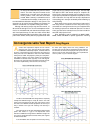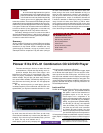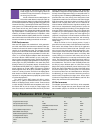
Any home theater that uses a CRT front projector capa-
ble of graphics- or data-grade resolution needs a way
to reduce the visibility of scan lines and remove inter-
lace artifacts, which become painfully unpleasant on a big
screen. Until recently the devices (line doublers) for doing
this with credible quality have cost over $7,500. For my own
modest home theater, with a 7-inch CRT front projector and 6-
foot wide screen, this price was beyond budget. My first pri-
ority was to find a way to convert the YPbPr component video
outputs of my DVD player to work with the RGB inputs of my
projector. I also needed input switching for my laserdisc and
VCR viewing.
The least expensive YPbPr-RGB converter, without line
doubling, is about $900 from Extron. I was about to buy one
of these when I discovered the $2,495 IEV Turboscan 1500 line
doubler. This unassuming black box performs the conversion
I needed, has switching functions, and does line doubling.
This remarkable device also includes separate adjustment of
video parameters (brightness, contrast, color, tint, and sharp-
ness) for each input, and overall adjustment for red, green,
and blue gain and offset levels. The former is important to me
for matching the slightly different output levels of my
laserdisc player to those of my DVD player. The latter is use-
ful for fine control of color temperature, especially for a pro-
jector like mine that doesn’t have digital controls for this func-
tion. Imagine my delight to find all of these features in a box I
could afford!
Description
The back panel of the Turboscan sports an on/off switch (nor-
mally left on), a power plug input, and a large array of video
input/output connectors. The composite and S-Video inputs
include buffered loop-through outputs. There is also an RJ-11
connector for a remote infrared control (IEV can supply this
or you can buy from a third party) and an RS-232 connector
for computer control of the unit (RS-232 programming com-
mands are in the manual).
My only complaint is that the VGA input connector
should be female, not male. All the readily available con-
nector cables, including VGA to 5-conductor BNC, or com-
puter to VGA monitor, terminate in a male VGA connector.
To use these on the Turboscan you have to use a female-to-
female adapter, creating a potentially unstable connection.
For an RGB input, the Turboscan can automatically
detect whether it is already progressive (as all computer
VGA outputs are) or whether it is interlaced; it can also be
forced into one or the other state. Thus I set up the Tu r-
boscan to accept a computer signal on the VGA input con-
nector (which also includes my 3Dfusion progressive DVD
player) and pass that through without dou-
bling. For laserdisc, I use the S-Video input
and for cable TV (via a VCR tuner) I use the composite
i n p u t .
The front panel of the Turboscan is clean, showing only
a small LCD panel and a touch panel control with left-right-
up-down arrows. The menu commands, displayed on the
LCD panel or on a simple onscreen block, are logically
linked in a circle, all accessible by the left-right arrows on
the front panel or the remote.
Remote Control
The Turboscan 1500 has many features beyond its line dou-
bling capability, most of which I have already mentioned. As
supplied by IEV, it comes with the excellent Home Theater
Master SL-8000 universal remote that includes the control
codes for over 500 devices (audio, satellite, TV, VCR, cable,
CD, DVD, and auxiliary). My Turboscan, along with my Elec-
trohome projector, came from Hi Rez Projections, Inc., of
Boston (www.hometheater1.com), which include Home The-
ater Master’s better remote, the SL-9000 with learning capa-
bilities. Both these units are wonderful, exceeded only by
remotes costing several hundred dollars.
Line Doubling = Deinterlacing
The name “line doubler” is misleading. These devices don’t
increase the total number of scan lines per video frame.
They deinterlace conventional NTSC video by replacing
each interlaced video field, which alternately displays only
the odd or even half of the frame’s scan lines, with a pro-
gressive video frame containing all of the scan lines. Dein-
terlacing is a complex process because the fields from a
video camera represent the image at different moments in
time. Simply merging fields together would create double
images of objects in motion, while interpolating new lines
between existing lines of each field produces a softer image.
Deinterlacing video sources is where most line doublers fall
down, the IEV included. That is not to say that it does a bad
job, though.
Film sources are converted to video by a telecine device
that repeats video fields at regular intervals, to convert the
2 4 - f r a m e - p e r-second film to 60-field-per-second video. This
is called 3-2 pulldown and creates an opportunity for a line
doubler to detect this pattern and reverse the process to
generate progressive video. For many years, only Faroudja
had special patented circuits to detect film sources with 3-2
pulldown and perform an inverse-telecine process to ideally
deinterlace them. (See Issue 24 for details of the inverse-
telecine process.) The Turboscan does not have inverse-
telecine deinterlacing and must process both video and film
sources using other techniques. The question is, how well do
they match up to the Faroudja standard?
The IEV Turboscan 1500 performs well with
B I L L C R U C E
IEV Turboscan 1500 Line Doubler


















